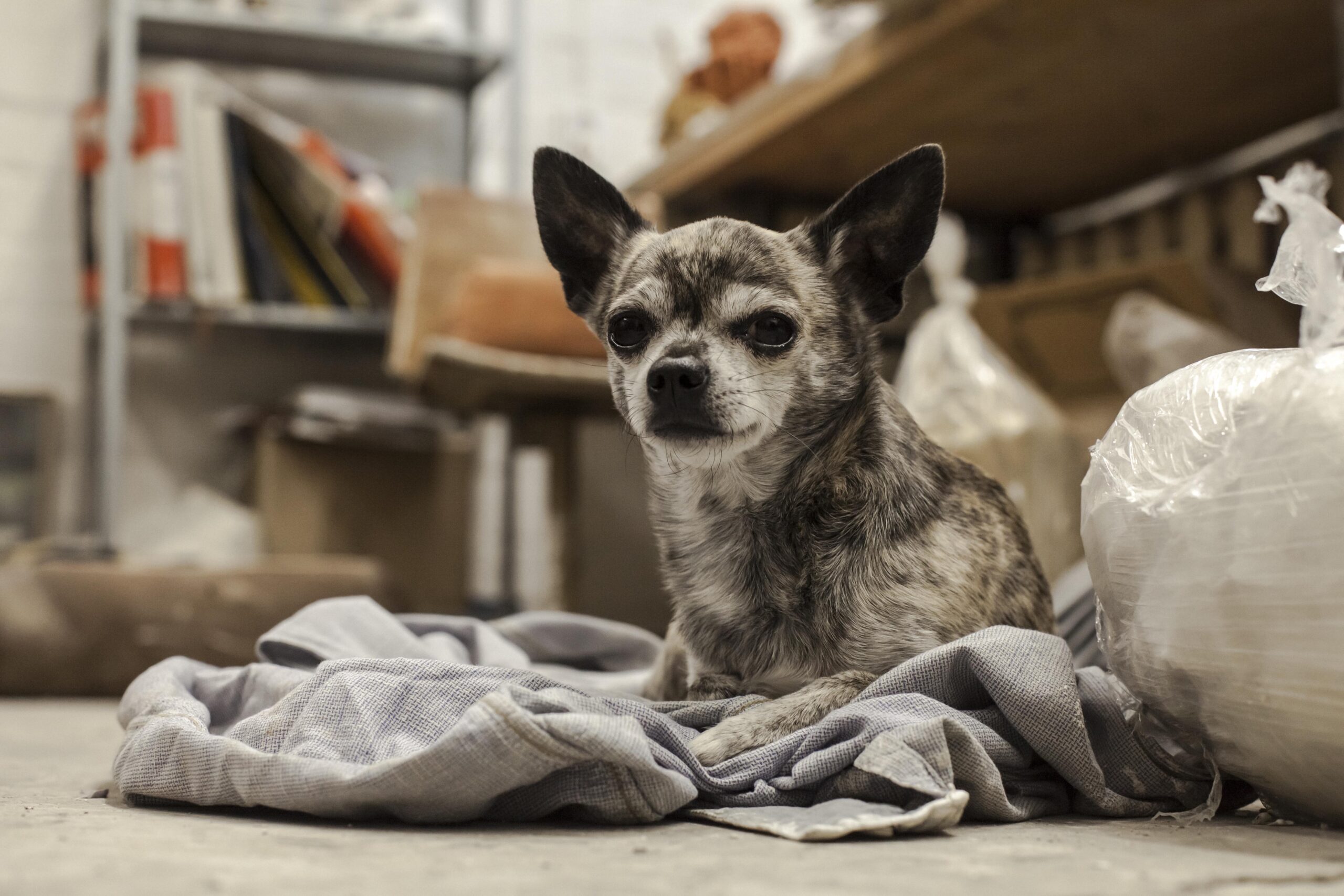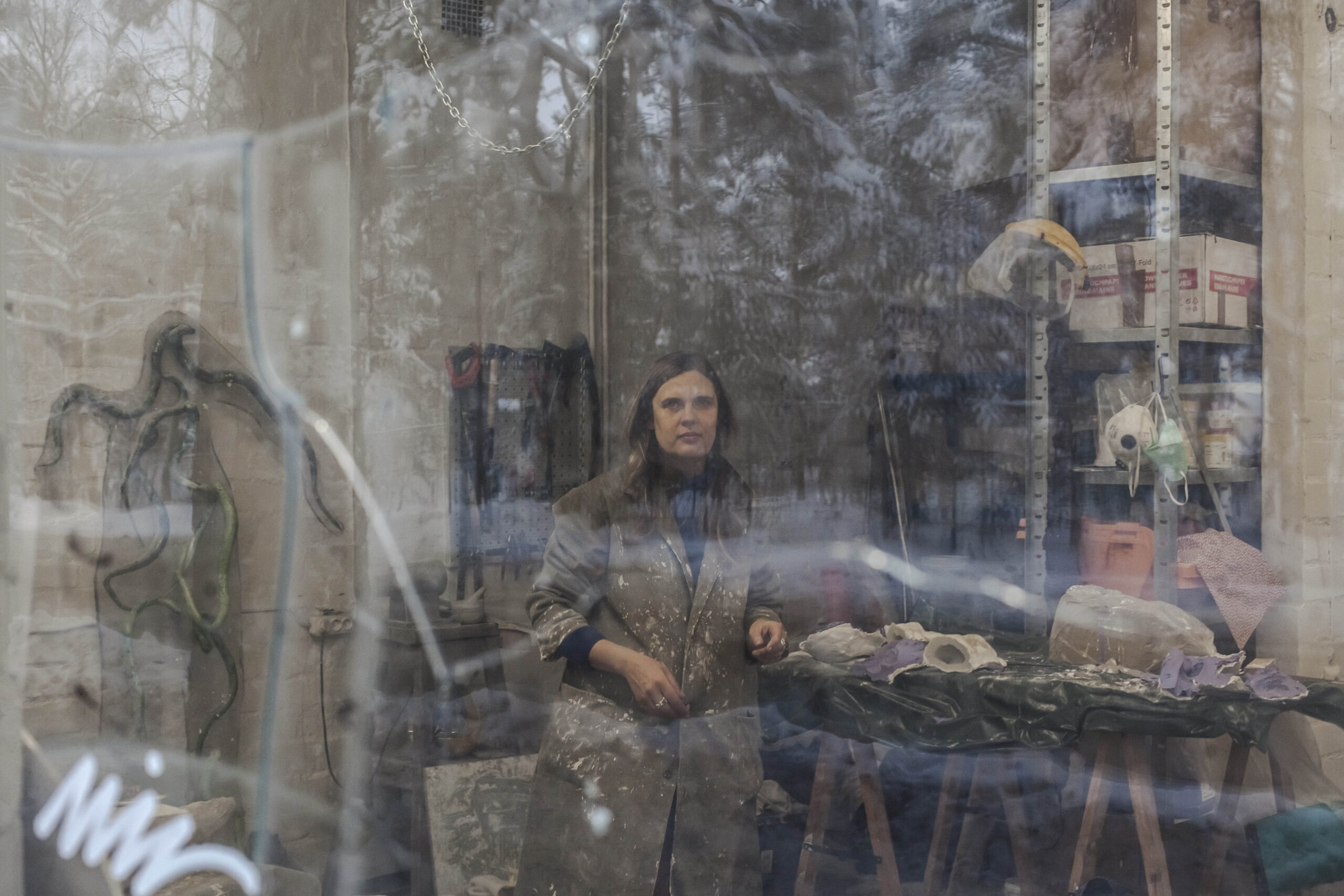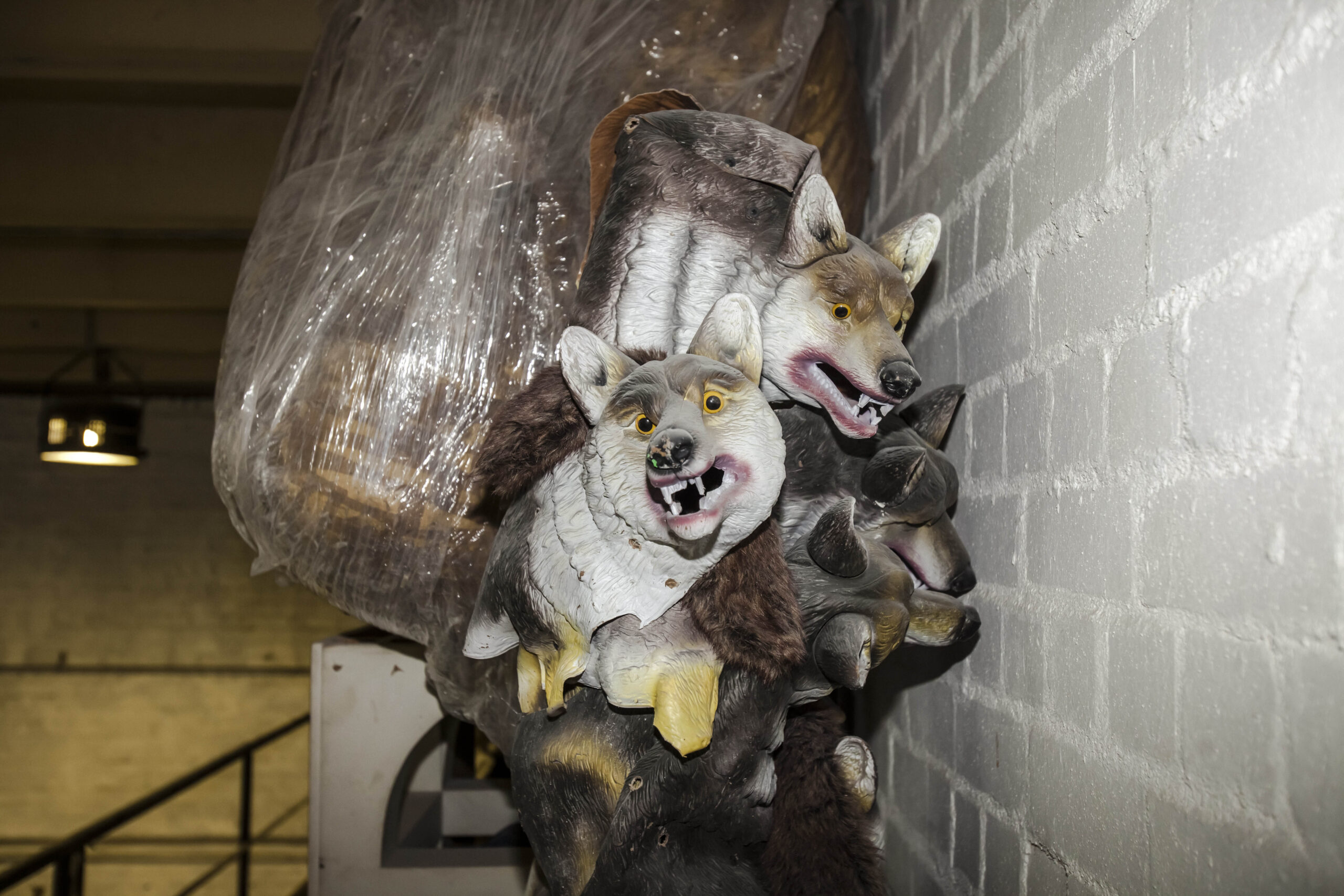
Edith Karlson belongs to the younger generation of Estonian sculptors, whose work is born out of experimentation with material and an artistic process that is often inarticulable in words. Her work has scope, both in terms of its scale and the themes she addresses, such as spirituality and the darker urges of humans. In 2024, Karlson is representing Estonia at the 60th Venice Biennale with an exhibition entitled Hora lupi. In the midst of preparing the new exhibit, she spoke to Cecilia Alemani about becoming an artist, her love for animals, motherhood and, of course, Venice.
When I visited your studio in Tallinn last September, I was greeted in the courtyard outside the building by a group of grey, towering figures, made of what seemed to be cement, their faces completely hidden by layers of veils or coverings. In hindsight, it seems a telling encounter with your work: I immediately thought of the classical reference to Rodin’s The Burghers of Calais while at the same time they evoked something unfinished, unmonumental and quite creepy. Who are these figures?
I began the series Drama is in Your Head in 2011 and worked with it until 2018. With the exception of a few projects, that was the title I used for all my works until 2018. The work you saw was Drama is in Your Head II. It was first presented in 2013. I had just turned 30. I filled the gallery with ghostly concrete figures about the size of a six-to-eight-year-old child, gathered around a concrete table with a vase of dried flowers on it, which I had received for my birthday. This work addressed my trauma of the social pressure and expectations about what a 30-year-old woman should have achieved in her life. At the time, I had nothing but a tiny dog and a computer. I felt I had failed as a person. I also remembered all too vividly how old 30-year-old people seemed to me when I was 17 – so incredibly old! That was a truly difficult time. Now, looking back, it's funny, of course, and you could say that life is difficult indeed when you're working on yourself.
You seem very confident when it comes to materials: bronze, concrete, clay, but also plastic and organic elements. Formally, your sculptures are incredibly tactile, sensual, even when abject, or not finished. Do you like to make everything yourself? Do you ever delegate or outsource parts of your production?
My attitude towards material is that I like to take it easy. I don't consider one material higher than another. I have a rather classical education in sculpture, which in the Estonian context means that sculptors mainly work with clay. All sorts of exciting materials like silicone, resin and epoxy became widespread in Estonia, which was part of the Soviet Union, way later than many other places in the world and so I'm curious to experiment with different materials. I'm not the one to measure and weigh everything out super precisely, which means that often things go wrong. But it also often happens that in the end, the wrong thing turns out to be precisely what I needed. And in general, yes, I've mostly done everything on my own. I'm bad at delegating and outsourcing but recently, the volume of production has grown, and it is no longer humanly possible for me to do everything alone. I've found super lovely and effective people, who sometimes help me out and I'm learning to be better at delegating. But still, I have to admit – I can't not go over the final details myself, with my own hands.
In your seemingly chaotic compositions, there is also a lot of irony going on. Do you see it as a productive tool?
I love irony but if there's too much, it can become really annoying. So, I think that irony alone is not the most productive tool, unless compassion, empathy and warmth is used alongside it. I appreciate it when warmth and irony are presented in balance.


Many of the characters in your universe are animals: giant dinosaurs, dogs, cats, snakes. It seems like your work brings out the most animalesque, instinctual, raw sides of these creatures, would you agree?
Can't argue there. I use the image of animals quite often to point to human things that at times make being human embarrassing, especially considering how we like to think of ourselves as the kings of nature. Animals rely on instinct and rawness to survive. In theory, humans could be a bit more refined in their choices.
You also showed me a picture of a seal skeleton you found on the beach. Have you turned it into a sculpture yet? Are you interested in death?
Yes, the seal became a work titled Short Story. A transparent plastic suit stands next to the seal skeleton. The work looks at the relationship between humans and animals; that is, their unequal power balance. Here, the animal is represented by death, the human by garments. And I am interested in death, yes. I have to admit that I'm afraid of death, although not dying myself but rather losing my loved ones. I'd like it not to be the case, I’d like to see it as a natural part of life, but in order to do so, we would have to live in a culture where death is not a taboo. I live in a place where death and ageing are not talked about and people have to experience them individually (through the death of their loved ones) and try to get used to it on their own. We all die.

And in reverse, did motherhood influence your practice? Is your son a source of inspiration? A collaborator? A critic?
It has been a tremendous influence. My whole world changed. In a positive way. It's good for your ego not to focus solely on yourself and your own issues. You concentrate and focus on somebody else's development and well-being and instead of yourself, another small human being becomes the centre of your world. Goodbye egoism. I definitely feel I'm a better person than I was before. But to each their own. At the same time, it's difficult too, of course; the worries of daily life and making art don't go together too well, and once you have a child, all sorts of worries come at you like a torrent. Until the age of three, my child almost never slept and that was an incredibly difficult time in my life. But now he's often in my studio and even without my encouragement, he has become a sculpture enthusiast – with his untainted and absolutely limitless fantasy, he has become a great source of inspiration to me. His works can also be seen at the Venice Biennale.
Tell us about your project for the Estonian Pavilion at the Venice Biennale. What is your approach there?
My main aim is to give sculptures a central position. I want to create a little world in each of the exhibition spaces and hopefully, people find that inexpressible something that touches them in their very core. Without words.

You also found an amazing space for the pavilion. What was most exciting about it?
The space really does play a significant role. When I stepped into that space for the very first time, I felt such joy of recognition – something that does not happen too often in life. At least in my life. The space is a decaying church. Glory in decay is something that has a massive emotional impact at least on me. We were looking for the perfect space for a long time and when we finally stepped into Chiesa di Santa Maria delle Penitenti, I immediately began to see how my works should be placed in each of the spaces. There will be a number of my previous works on display but also new ones that I have been thinking about and planning for years. There, everything started to acquire a natural flow. The space made me excited and gave me a will to do things, which I have not felt for a long time. I truly like the space. There is a strong contrast between the ceremonial atmosphere and decay – it is simultaneously beautiful and inevitable.
If you could choose an exhibition setting, what would it look like? A white cube gallery space, or an industrial rougher context? Somewhere outdoors? I saw your dinosaur outside, in front of an old industrial complex in Tallinn. Was it your first time confronting the public space? Have you overheard any amusing comments in response to your work?
Because my studio is a rough industrial environment, I inevitably feel the most at home in similar spaces and that would be my first preference as well. But that is also in my comfort zone, and I do enjoy the challenge different spaces pose. I would say that the space is not an obstacle if I find something that triggers me even a tiny bit. It's more about attitude. When it comes to works in public spaces, I have a couple more. People love the dinosaur, that is no surprise to me, of course... people are easily impressed. Soon a larger-than-life bronze cat with mice crawling in its hair I sculpted will be installed in the public space in Tallinn. I made it just the right size, so that children and even adults can easily climb onto the cat. I'm so looking forward to seeing it. When I climbed on the cat myself and sat there, it was so comfortable and I really hope that it will make children happy, that it will become part of their childhood memories, just like a lion in a park in Tallinn was mine.
Did you always want to be an artist?
I think I just didn't know I could be an artist – I had no idea what it means. But I did know that I wanted to study at an art academy, because that was the only type of higher education I was able to get through. I thought that was the place where people were normal – the kind of people I'd like to spend time with. Becoming an artist wasn't really a goal in itself.

You have collaborated with other visual artists in the past, like Kris Lemsalu. How do you choose your collaborators and what do these collaborations add to your practice?
I don't choose anything. Things just happen to me because I'm a yes-man. That is, of course, my weak spot. I just keep saying yes to everything. But that has also brought a lot of joy, excitement and work into my life. I can only dream of saying no, although I do try to practice that sometimes... Unfortunately, on my loved ones. The thing with Kris is that she happens to be one of my best friends, so working with her comes naturally. Sometimes I've helped her with her work and she has done the same for me. What I really enjoy in Estonia is that artists often help each other out. When someone is working on a bigger project, they ask their colleagues for help, and I think that is truly beautiful. I've often worked with Jass Kaselaan. Although sculpture is not always the focus of my creative collaborations. For example, I've taken photographs for several of Julia Heuer's collections. I've also collaborated with theatres on stage design projects and that has actually become one of my other jobs. In theatre, everything you do is a collaboration and that is always a good shift away from my time alone in the studio. On top of that, I also do sound collaborations. My partner and I have a band. Sound has always been important in my work and now that I'm really focusing on it, I'm getting better at it. I strongly believe in collaborating!
What is your home like?
My home is a place I would never want to leave, I always miss it. And I like it more and more. This has been one of my biggest dreams in life and because it came into my life through hard work and even suffering, I feel no shame in saying that I am very happy and proud of my home.
How did the pandemic influence your practice?
That is something I don't really want say out loud but okay then. The thing is, I'm an incredibly lucky person to have a country house on an island and I'd like to spend all of my free time there. I don't have much free time, though. When the pandemic started, I was on the island with my family, and it so happened that my best friend's family was also there and then the island went into lockdown. Nobody could leave. And we were there for over a month. I had none of my work stuff with me, everything was postponed. And I just let everything go. I'm afraid that was one of the happiest times in my life. I observed how spring came, little by little. I was watching the grass and my child grow. That was a time for myself, something I hadn't had for so long and I really needed it. I also felt guilty in my bubble of happiness because a friend of mine was living in New York and there, her life was completely different from mine, which was so in sync with nature. She suffered from depression and I was content and happy... Totally unfair, I know, but that's how it was. When we were allowed to leave the island again, I was full of energy and soon after made one of my biggest and strongest exhibitions, Return to Innocence.
If you could move to another city, where would you go?
There are so many cities I have never been to, so I don't want to make any bold claims. I'd love to see all kinds of places but moving is another thing. When life offers me something, I accept but… I don't know, I don't really have a preference, personally.